 After the deluge: The Jatayu Earth Centre. (Courtesy: Jatayu Earth Centre)
After the deluge: The Jatayu Earth Centre. (Courtesy: Jatayu Earth Centre)
The Kuttanad waterscape, which skirts Alleppey and Kottayam in Kerala, is fed by five rivers, with mud, silt and soil from the Western Ghats pouring itself into this mix of salt and sweet water. It’s also the inspiration for the famous Onam song, Kuttanadan punchayile, which celebrates the romance of the backwaters, its flora and fauna, the victory of the boat race, and the sweet voices of its children. The catastrophic floods in August this year changed that. Could there be new songs, new slogans to bring back a lost landscape?
A month after the deluge, Kerala was back on its feet, hosting Kerala Tourism Mart (KTM) in Kochi last month, the largest convention for a single destination. Of its 700-strong member group, more than half had stalls inviting buyers from across India and the world, saying “Kerala is open”. Many entrepreneurs, big and small, be they homestay owners or luxury hotels, were saying, “We are back in business.” Some were honest enough to confess that currently there is no strategy to make their properties more environment-conscious. “If we can get our bookings till Diwali, we can make plans. Currently, we are just coming up for air.”
The Kuttanad landscape is hard to identify anymore. The paddy fields and backwaters have merged. While houses have a fresh coat of paint, people seal their lips about the past. What can one say when the kalkettu (quay) that held the floodwaters back for generations, forgot its boundaries? Boatman Samban points to the egrets that plunge into the water to catch fish: “It’s a bit like that, we’ve been swallowed up.” The Spice Routes-Luxury Cruises office that sits on the riverbanks did see the water swell up and into the rooms. However, the four-hour cruise on the Pampa was their way to say that it’s all water under the bridge now.
“We’ve bounced back, and a lot has to do with the public-private partnerships in the state,” says Abraham George, former president, KTM, and chairman and managing director, Intersight Tours and Travels. “We have formed committees in major destinations and with the local bodies we are cleaning up the area. In Fort Kochi, Thekkady, Kovalam, Wayand, and Munnar, we, as a trade body, are actively involved,” he says.
 A boat plies on the Alleppey backwaters.
A boat plies on the Alleppey backwaters.
An ambitious public-private partnership enterprise is the Jatayu Earth Centre in Chadayamangalam, about 50 km from Thiruvananthapuram. Against the backdrop of the Western Ghats, a colossal 200-ft concrete sculpture of Ramayana’s mythical bird, Jatayu, with its clipped wing, sits atop a rock. Here, Rajiv Anchal, filmmaker and art director, conceived a place — spread across 65 acres — for adventure activities, cable cars, wilderness treks, restaurants, wellness centre and camping sites. The state government is promoting it as an eco-tourism destination. It is also helping rehabilitate weavers from Chendamangalam and mirror workers from Aranmula by setting up their looms and getting their workshops back in place — as a part of responsible tourism projects.
Across the length of the state, there’s no way of telling the state is recovering from such a calamity. It’s only when one crosses junkyards with discarded doors and cupboards, and mechanic shops filled like parking lots with disused cars, that reality dawns. “The flood has given us many stories. In it, both the good and bad have surfaced. And while we see only the physical disruption, we don’t see the floods within. For many people, returning is going to be a long journey,” says Saji K of Oorali, an artists’ community from Thrissur.
The five-year-old group has been working in relief camps in Pathanamthita and Ernakulam. As part of the Kochi Muziris Biennale, they will travel along the Kerala coast, thanking fisherfolk for their support during the floods. “For the fishermen, water is their life; they are connected to water in a much deeper way. We will be travelling along the coast to listen to their stories and songs.”
The writer was a guest of Kerala Tourism.